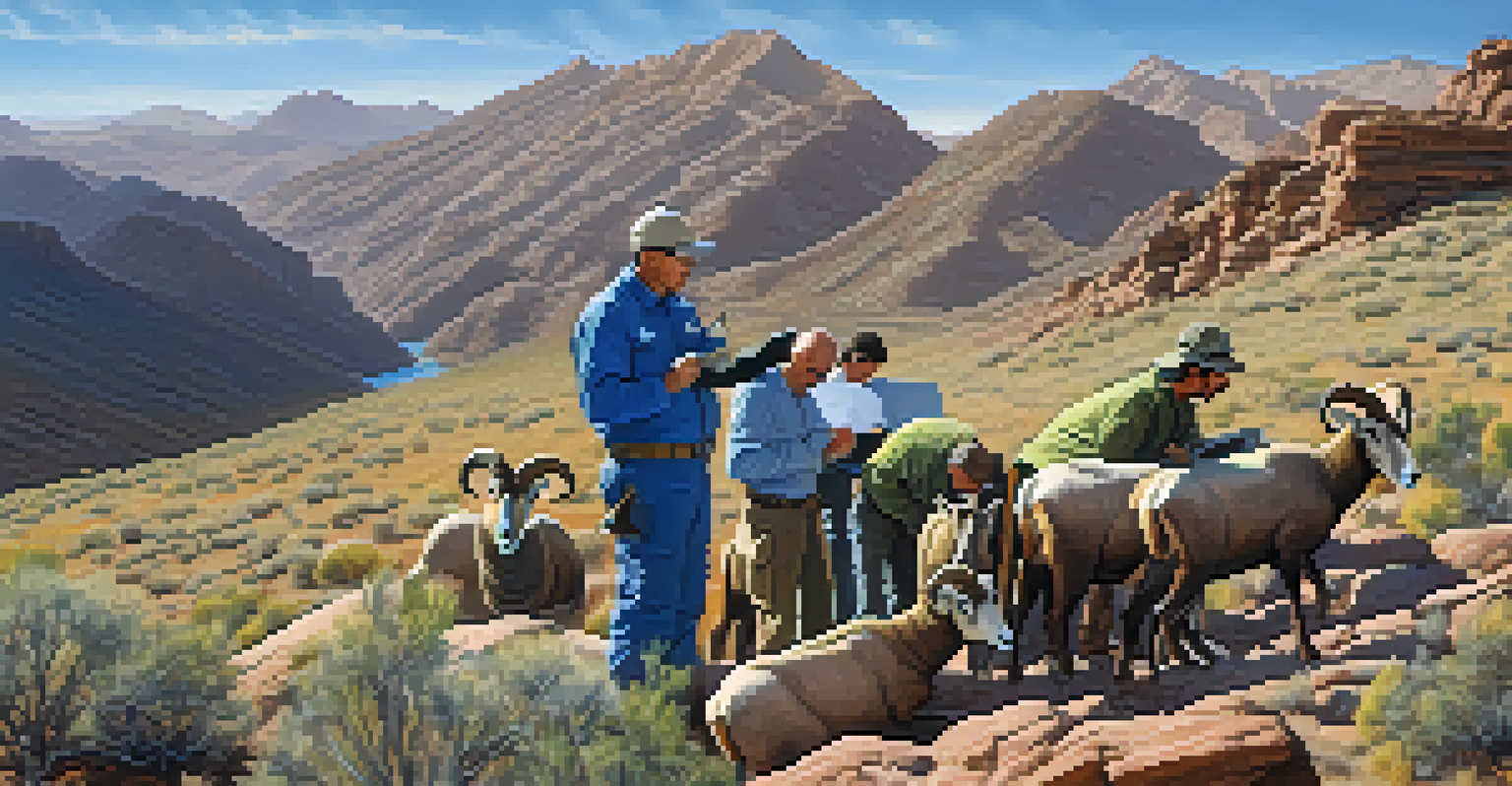Innovative Technologies Used in Arizona Wildlife Research

Drones: The Sky's the Limit for Wildlife Monitoring
Drones have revolutionized the way researchers in Arizona study wildlife. With their ability to cover vast areas quickly, these flying devices provide real-time data on animal populations and habitats. For example, drones equipped with high-resolution cameras can capture images of elusive species that are difficult to observe on the ground.
The future will be about much more than just data. It’s about how we interpret that data to create meaningful change for wildlife and their habitats.
Additionally, drones help minimize human disturbance, allowing scientists to monitor sensitive areas without causing stress to wildlife. This approach not only yields more accurate data but also enhances the safety of both the animals and the researchers. By utilizing this technology, researchers can gather critical insights into animal behavior and habitat usage.
Moreover, the data collected from drones can be analyzed using sophisticated software, creating detailed maps and models of ecosystems. This innovation not only aids in wildlife conservation efforts but also helps inform land management decisions that balance ecological needs with human activities.
Camera Traps: Unseen Moments Captured
Camera traps are another exciting technology that has made a significant impact in wildlife research across Arizona. These motion-activated devices provide a glimpse into the lives of animals that researchers might never see otherwise. By strategically placing these cameras in various habitats, scientists can collect valuable information on species diversity and population dynamics.

For instance, researchers have used camera traps to monitor the presence of endangered species like the desert tortoise. The data gathered helps conservationists track their movements and understand the threats they face in their natural habitats. This non-invasive method ensures that the animals are not disturbed, allowing for more authentic behavioral observation.
Drones Enhance Wildlife Research
Drones provide real-time data on wildlife populations while minimizing human disturbance in sensitive habitats.
Moreover, the images captured by these cameras contribute to a broader understanding of ecosystem health. By analyzing patterns in animal activity, scientists can identify areas that need protection or restoration, ultimately supporting conservation efforts and biodiversity.
GPS Collaring: Following Animals on Their Journeys
GPS collaring is a game-changer in wildlife research, providing detailed insights into animal movements and behaviors. In Arizona, researchers attach lightweight collars to animals, enabling them to track their locations in real-time. This technology allows scientists to study migration patterns, habitat preferences, and social interactions among various species.
Technology is not a substitute for nature, but it can be a valuable ally in our efforts to protect it.
For example, GPS collars have been instrumental in understanding the movements of the iconic bighorn sheep in Arizona's mountainous regions. By analyzing the data, researchers can identify critical habitats that need protection and assess the impact of human activities on these majestic animals. This information is vital for creating effective conservation strategies.
Additionally, the data collected from GPS collars can be used to educate the public about wildlife behavior and conservation efforts. By sharing these insights, researchers can foster a greater appreciation for Arizona's unique ecosystems and encourage community involvement in protecting them.
Acoustic Monitoring: Listening to Nature's Symphony
Acoustic monitoring is an innovative approach that allows researchers to listen to the sounds of wildlife, providing valuable data on species presence and behavior. In Arizona, scientists use specialized recording devices to capture the vocalizations of birds, amphibians, and even insects. This technology is particularly useful for studying elusive or nocturnal species that are challenging to observe visually.
For instance, researchers have employed acoustic monitoring to assess the health of desert ecosystems by analyzing the calls of various frog species. By comparing sound recordings over time, scientists can detect changes in populations and habitat conditions, informing conservation efforts. This method offers a unique perspective on biodiversity that may go unnoticed in visual surveys.
Community Engagement Boosts Conservation
Involving local residents in wildlife monitoring efforts fosters stewardship and enhances data collection.
Moreover, the data collected through acoustic monitoring can be shared with the public, raising awareness about the importance of soundscapes in ecosystems. By highlighting the intricate relationships between species and their environments, researchers can inspire a deeper connection to nature.
Remote Sensing: Mapping Change from Above
Remote sensing technology has become an invaluable tool in wildlife research, allowing scientists to monitor environmental changes from a distance. In Arizona, satellite imagery and aerial surveys provide critical data on habitat changes, land use, and climate impacts. This information is essential for understanding how wildlife is affected by these changes and for developing effective conservation strategies.
For example, remote sensing has been used to track the effects of drought on desert habitats, revealing how these conditions impact local wildlife. By integrating this data with ground-based research, scientists can gain a comprehensive understanding of ecosystem dynamics and species responses. This holistic approach enhances the effectiveness of conservation initiatives.
Additionally, remote sensing data can be utilized to engage stakeholders in conservation efforts. By visualizing habitat changes through maps and images, researchers can effectively communicate the urgency of protecting wildlife and their habitats to policymakers and the public.
Data Analytics: Turning Raw Data into Actionable Insights
The integration of data analytics in wildlife research has transformed the way scientists interpret and utilize information. By collecting vast amounts of data from various technologies, researchers can employ analytical tools to identify patterns and trends in wildlife populations. This process not only enhances understanding but also supports informed decision-making in conservation efforts.
For instance, data analytics has been used to model animal behavior and predict responses to environmental changes. By examining factors like climate variability and habitat loss, scientists can anticipate challenges that wildlife may face and proactively develop conservation strategies. This predictive capability is crucial in a rapidly changing world.
Future Tech Transforms Wildlife Studies
Innovations like AI and virtual reality promise to deepen insights and public engagement in wildlife conservation.
Furthermore, the sharing of analytical findings with the public can foster a greater understanding of conservation issues. By presenting data in engaging formats, such as interactive dashboards or visualizations, researchers can inspire community involvement and support for wildlife protection initiatives.
Community Engagement: Involving Locals in Research
Community engagement is a vital component of successful wildlife research in Arizona. By involving local residents and volunteers, researchers can enhance data collection efforts and foster a sense of stewardship for the environment. Citizen science projects, where community members contribute to wildlife monitoring, have become increasingly popular and effective.
For example, local volunteers can assist in setting up camera traps or recording acoustic data, providing researchers with valuable insights while also learning about their local ecosystems. This collaborative approach not only increases data collection capacity but also builds a community of informed advocates for wildlife conservation.

Engaging the community also helps raise awareness about the challenges wildlife face and the importance of protecting their habitats. By sharing the outcomes of research with the public, scientists can create a shared sense of responsibility and encourage collective action toward conservation goals.
Future Trends: The Next Frontier in Wildlife Research
As technology continues to advance, the future of wildlife research in Arizona looks promising. Innovations like artificial intelligence (AI) and machine learning are poised to further enhance data analysis, enabling researchers to draw deeper insights from complex datasets. These tools can automate the identification of animal species from camera trap images, streamlining the research process.
Moreover, the integration of virtual reality (VR) could offer new ways to engage the public in wildlife conservation. By immersing people in the habitats of endangered species, VR experiences can evoke empathy and inspire action to protect these animals and their environments. This exciting technology could transform how we connect with the natural world.
Ultimately, the continuous development and application of innovative technologies will empower researchers to tackle pressing conservation challenges. By combining cutting-edge tools with community involvement, Arizona can lead the way in wildlife research and protection, ensuring a brighter future for its diverse ecosystems.